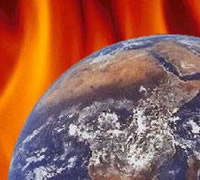New scientific modelling suggests the earth's average temperature could rise by 7.8°C by 2300 if fossil fuel consumption remains unchanged, with polar ice caps melting and seas rising by seven meters.
New climate modelling by researchers at the Lawrence Livermore National Laboratory in California suggest the magnitude of global warming could be much higher than expected, with dire consequences for the economy.
The researchers' simulations show that, if humans use the entire planet's available fossil fuels by the year 2300, the polar ice caps will be depleted, sea levels will rise by seven meters and median air temperatures will soar to 7.8°C warmer than the present day. The Arctic and Antarctic would be hardest hit with temperatures there rising more than in the tropics, by more than 20°C, forcing the land in the region to change from ice and tundra to boreal forests.
Separate research performed by scientists at the Harvard Medical School of Public Affairs point to significant impact of climate change on human health with dire costs for the economy and significant impact on the insurance industry.
Rates of vector-borne and infectious diseases such as lyme and malaria are expected to increase as ticks and mosquitoes responsible for their transmission proliferate. These are expected to affect African countries most but also other regions such as North America, the researchers pointed out. Rising incidence of asthma is also expected as emissions of carbon dioxide rises. The study was co-sponsored by Reinsurance firm Swiss Re and the United Nations Development Programme (UNEP).
"As a reinsurance company, our goal is to evaluate and plan for the long-term," said Jacques Dubois, Chairman of Swiss Re America Holding Corporation. "This report provides a crucial look at physical and economic aspects of climate change. It also assesses current risks and potential business opportunities that can help minimise future risks.




 By: N. Peter Kramer
By: N. Peter Kramer
